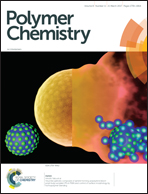Asymmetric Michael addition in an aqueous environment with the assistance of optically active hyperbranched polymers†
Abstract
Herein, we report a novel category of optically active hyperbranched polymers (HBPs) that can serve as a recyclable chiral host platform to promote the asymmetric Michael addition reactions in aqueous environments. The chiral hydrophobic cavities within the HBPs provide a chiral microenvironment for the asymmetric Michael addition with a high product yield of up to 89% and satisfactory enantioselectivity. HBPs-6 (prepared with pure D-type chiral monomer) and quinine can work together in a synergistic way, which leads to an enhancement in catalytic stereoselectivity. However, for HBPs-1 (prepared with pure L-type chiral monomer), the catalytic stereoselectivity of quinine within the L-type chiral hydrophobic cavities is slightly suppressed since the quinine units are very likely to be shielded by the polymer chains. The present study not only provides a catalyst scaffold to achieve high yield and enantioselectivity for the asymmetric Michael addition in aqueous environments, but also is of great fundamental value for the rational design of artificial synthetic materials in approximating enzymes.



 Please wait while we load your content...
Please wait while we load your content...